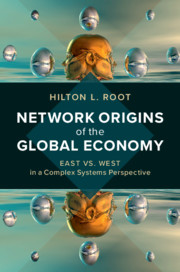Book contents
- Network Origins of the Global Economy
- Network Origins of the Global Economy
- Copyright page
- Dedication
- Contents
- Figures
- Tables
- Contributors
- Preface
- Overview
- Acknowledgments
- Part I Political Economy and Complex Systems
- Part II An Analysis of Historical Regimes
- 4 Network Assemblage of Regime Stability and Resilience in Europe and China
- 5 Network Formation and the Emergence of Law: From Feudalism to Small-World Connectivity
- 6 The Network Foundations of the Great Divergence
- Part III The Coming Instability
- References
- Index
4 - Network Assemblage of Regime Stability and Resilience in Europe and China
from Part II - An Analysis of Historical Regimes
Published online by Cambridge University Press: 17 March 2020
- Network Origins of the Global Economy
- Network Origins of the Global Economy
- Copyright page
- Dedication
- Contents
- Figures
- Tables
- Contributors
- Preface
- Overview
- Acknowledgments
- Part I Political Economy and Complex Systems
- Part II An Analysis of Historical Regimes
- 4 Network Assemblage of Regime Stability and Resilience in Europe and China
- 5 Network Formation and the Emergence of Law: From Feudalism to Small-World Connectivity
- 6 The Network Foundations of the Great Divergence
- Part III The Coming Instability
- References
- Index
Summary
The first of the book’s five great transitions is the creation of institutions of dynastic succession in Europe and China. Orderly, incontestable hereditary succession afforded dynastic longevity from the ninth century onward, and was a key institutional determinant of long-term economic performance, serving as a hypernetwork that contributed to system-level dynamics. The hypernetwork structures in Europe and China were very different, one being scale-free, the other star-like. Each presented trade-offs between properties of stability and resilience that arose according to widely different adaptive strategies. Historical meta-regimes offer evidence that qualities embedded in macrostructures are distinct from those at the micro levels, and that long-standing institutions are likely to be gradual in formation, but sudden in their demise. Redundancies in Europe’s network of connected dynasties ruling across the continental “fabric” lent resilience to the macro-system. China's system distributed information more efficiently, but with the attendant risk that the collapse of a lone central hub reliant on a powerful bureaucracy would produce cycles of decay during which the population suffered on massive scales.
Keywords
- Type
- Chapter
- Information
- Network Origins of the Global EconomyEast vs. West in a Complex Systems Perspective, pp. 79 - 111Publisher: Cambridge University PressPrint publication year: 2020

